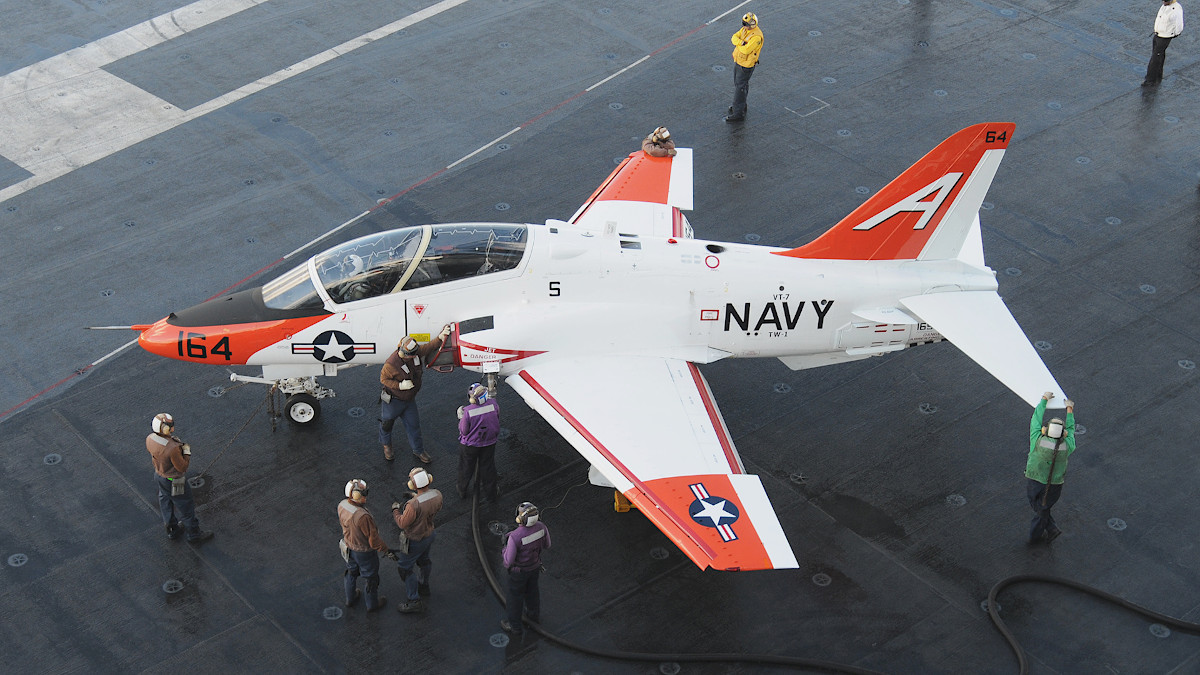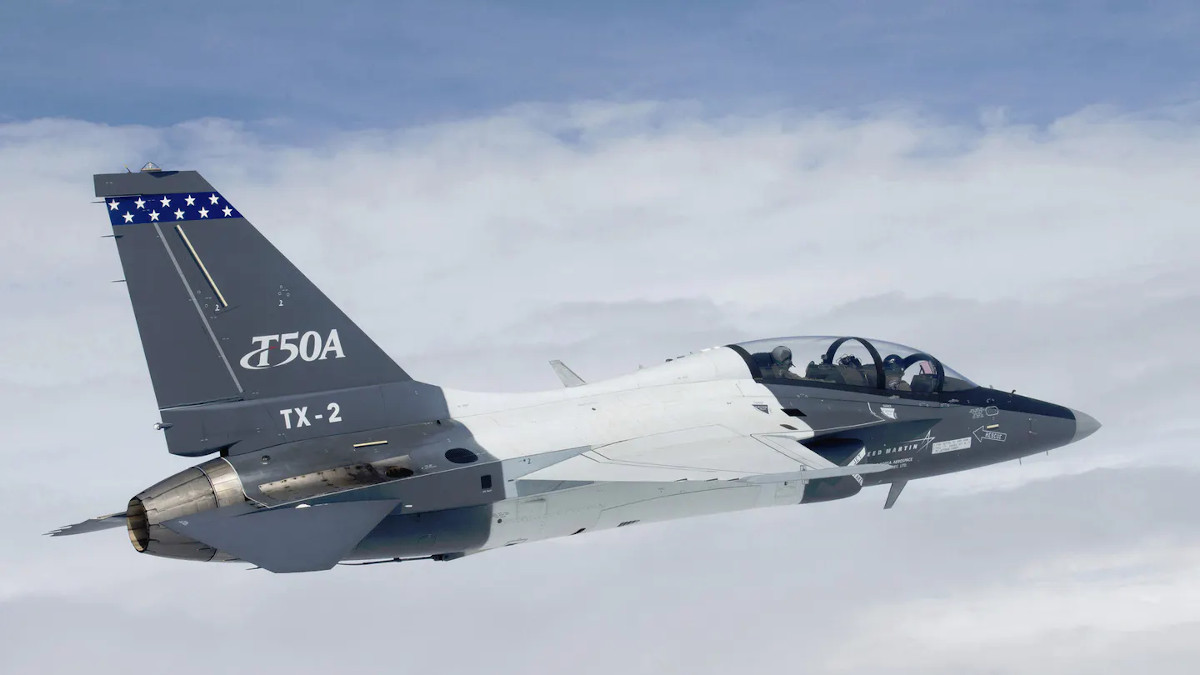The U.S. Navy is looking for a new carrier jet trainer that could replace its aging T-45 Goshawks. Most interestingly, the service says it is looking to buy an existing land-based design that would be limited to doing touch-and-gos on aircraft carriers and would be unable to perform catapult launches from or arrested landings on those ships. This would be a radical change that would have major implications for much of the Naval Aviator training pipeline.
FlightGlobal
was first to notice that the Naval Air Systems Command (NAVAIR) had posted a request for information regarding what it is formally calling the Undergraduate Jet Training System (UJTS) on May 14, 2020. There is no firm publicly available schedule, so far, for when the Navy might begin buying any of these aircraft, which it also refers to as the T-XX, but the service says that it does want to begin replacing the T-45s around 2028.
Right now, NAVAIR is interested in getting information “on the suitability of an existing land-based jet trainer aircraft design (i.e. nondevelopmental, as defined under FAR [Federal Acquisition Regulation] 2.101) to satisfy certain requirements under consideration for the next generation US Navy undergraduate jet trainer aircraft,” according to the notice on the official U.S. government contracting website beta.SAM.gov. “Of particular interest, and the subject of this RFI [Request for Information], is the capability of a nondevelopmental aircraft to perform Field Carrier Landing Practice (FCLP) events and Carrier touch-and-go events, and the corresponding effects of these high sink rate landings.”
“The information provided in response to this RFI will be used to assess the current state of technology and inform whether the candidate system(s) can satisfy the capability requirements to perform missions in support of Chief of Naval Air Training (CNATRA) T-45 Combined Multi-Service Pilot Training System (i.e., CNATRAINST 1542.167B) and the Advanced Strike Fighter Undergraduate Military Flight Officer Training System syllabi (i.e., CNATRAINST 1542.164A),” the notice adds.

The Navy says it expects to fly each UJTS aircraft for 400 flight hours each year. The jets would conduct around 1,200 Field Carrier Landing Practice (FCLP) landings using simulated facilities ashore, as well as up to 45 touch-and-gos on actual carriers, annually.
The proposed purchase of a land-based jet trainer design that cannot actually land or takeoff from an aircraft carrier would be a major shift om how the Navy trains its fighter pilots. The T-45, which first entered service in 1991, is a carrier-capable variant of the well-established BAE Hawk series and replaced the existing carrier-capable T-2C Buckeye and TA-4J Skyhawk in the intermediate and advanced jet trainer roles, respectively.

Launching from and recovering on an aircraft carrier is a highly complex and challenging affair under the best conditions and requires significant and routine training to develop and maintain the requisite skill sets. Being able to train pilots to perform these landings and takeoff through FCLP training using simulated facilities on land and with touch-and-gos on actual carriers would certainly provide valuable experience, but would not be a full substitute for the actual carrier qualifications that aviators can currently get while flying in the T-45 Goshawk.


It’s not clear from the contracting notice if the land-based design would actually be the only replacement for the T-45, as NAVAIR itself has made clear that it will only be able to meet “certain requirements” for the UJTS program. The War Zone has already reached out for additional information and clarification.
It’s certainly true that the T-45s, of which the Navy and the Marine Corps have around 194 in service in total, the oldest of which are now more than three decades old, are increasingly in need of a replacement. The Navy had originally planned to phase them all out in 2018, but, five years before, made to decision to instead extend their service life through 2042. The Goshawks fleet’s readiness rates have slipped in recent years, raising concerns about the service’s ability to train an adequate number of pilots each year. In 2019, the Government Accountability Office also warned about potential shortfalls in available aircraft as jets went through the planned Service Life Extension Program.
The T-45 fleet also suffered a worrying and deadly spate of hypoxia incidents between 2016 and 2017. Various fixes to the aircraft themselves, as well as the Navy’s operating procedures, have reduced the number of subsequent physiological events in the past three years, but identifying the underlying root causes has proven difficult.
Buying an existing land-based design made to Navy specifications, but without having to modify it to withstand the stresses of catapult launches and arrested landings, could offer a low-cost, low-risk path for the Navy to acquire new jet trainers. One obvious option would be to acquire a version of the U.S. Air Force’s new T-7A Red Hawk, the production of which started in January. The War Zone has already detailed the many possible future roles for the T-7A, or derivatives thereof, in the past.
There are also a number of other proven and in-production land-based jet trainer designs available, including the losing entrants for the Air Force’s T-X competition, which the T-7A won. The Air Force itself recently exploring buying a small number of South Korean-made KAI T-50 Golden Eagles to support its own transformational fighter jet pilot training plans. That service canceled its proposed sole-source purchase of the T-50s in March and now says it will hold an open competition.

At the same time, whatever cost-savings the Navy might find by pursuing this course of action might be offset, at least in part, by changes that would then be necessary to its fighter pilot training pipeline. Those aviators will still need to conduct carrier qualifications and will need suitable aircraft in which to perform them. Even simply using existing F/A-18E/F Super Hornets to meet these requirements would increase the number of flight hours those jets have to dedicate to training missions, potentially pulling them away from other activities. These full-up fighters are also costly to operate.
It is worth noting that the Navy is making substantial investments in developing and fielding various technologies to help automate carrier landings. It is possible that this could eventually reduce the amount of required carrier qualification training the service feels is required, but it wouldn’t eliminate it entirely. At the same time, carrier qualifications have been getting steadily pushed farther and farther down the pipeline.
The Navy has already done something broadly similar with regards to its C-2 Greyhound and E-2 Hawkeye aircraft. Prospective pilots destined to fly those aircraft conduct much of their training in the T-44, a variant of the Beechcraft King Air, which is also not carrier-capable. It’s not clear how that training pipeline may also now change as the C-2s get replaced by the CMV-22B Osprey tilt-rotor. Still, as long as manned fighter jets operate from its carriers, there will be a need to have those pilots practice the uniquely complicated process of landing on, as well as taking off from, those flattops.
Regardless, the Navy’s plans to buy non-carrier-capable jet trainers to replace its T-45s, even in part, points to major changes coming in how the service prepares prospective fighter pilots for the challenges involved in joining its carrier air wings.
Contact the author: joe@thedrive.com
